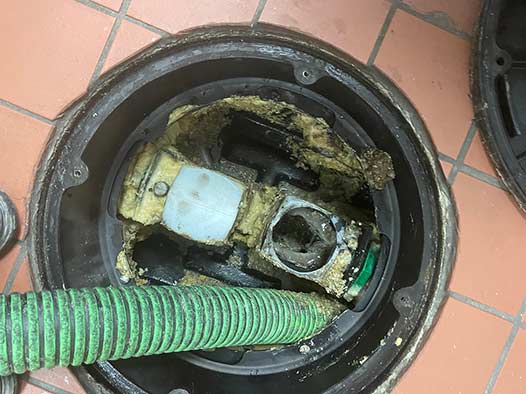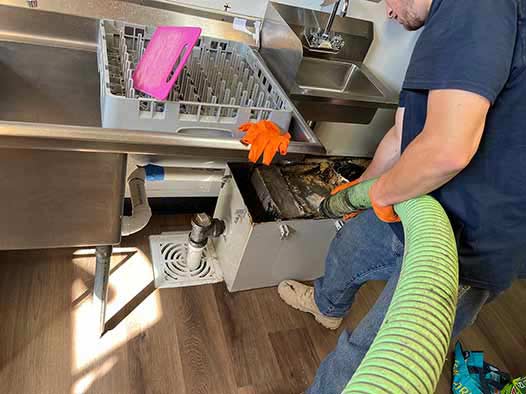
Grease traps play an integral role in the smooth operation of any commercial kitchen, serving as a guardian against blockages in the plumbing system. While they operate out of sight, their maintenance should never be out of mind. Timely grease trap pumping service is critical to prevent the build-up that leads to unpleasant and costly complications. We will help you recognize the telltale signs that it’s time for a pump-out and offer practical advice to keep your kitchen running without a hitch.
Understanding Grease Traps
The Role of Grease Traps
In a busy commercial kitchen environment, a grease trap is more than just a component; it’s a necessity. It works tirelessly to capture fats, oils, and greases, known collectively as FOG, that come from cooking, preventing these substances from entering and clogging the municipal sewage system. Overlooking its importance can lead to a domino effect of plumbing issues that can halt kitchen operations and attract health code violations.
How Grease Traps Work
The mechanics of a grease trap are simple yet effective. Wastewater from kitchen sinks flows into the trap, designed to separate FOG from the water. The FOG rises to the top due to its lower density, while heavier solids settle at the bottom, allowing relatively clean water to exit the trap. However, the grease trap has a limit to how much FOG it can hold. When it approaches this limit, the efficiency of the separation process drops, signaling that it’s time for a pump-out.
Types and Maintenance
Understanding the kind of grease trap your kitchen utilizes is the first step toward proper maintenance. Whether it’s a small passive trap located directly beneath the sink or a larger in-ground unit serving an entire facility, each type requires a specific approach to pumping and cleaning. Identifying your system will help you establish a maintenance routine that ensures its longevity and reliability.
The Indicators of Grease Trap Distress
Slow Drainage
When water takes longer than usual to drain in your sinks, it’s not just a minor inconvenience; it’s a symptom of a grease trap nearing its capacity. Allowing the trap to overflow can lead to a total blockage, so slow drainage should prompt a call to your grease trap pumping service provider.
Bad Odors
A well-functioning grease trap is rarely smelled. If a strong odor begins to emerge from your drains, it’s a clear sign that the trap is filled with decomposing organic matter, and grease trap pumping should be arranged without delay.
Visible Grease
Grease making an appearance in places where it doesn’t belong is a red flag. When you start noticing grease in secondary drain areas or floating on the surface of standing water, it indicates that the trap can no longer contain the FOG, and a pump-out is necessary to prevent a slippery mess.
Increased Pest Activity
A surge in pest sightings can be an unexpected but accurate indicator that your grease trap needs attention. Pests are attracted to the food particles and FOG that accumulate in poorly maintained traps. Regular pumping can help prevent these unwelcome guests from invading your kitchen.
Monitoring Grease Levels
Keeping an eye on your grease levels is as important as any other maintenance task. Consistently monitoring levels can preclude many issues with cast iron stacks, which are particularly susceptible to grease buildup.

A customized maintenance schedule is the key to preventing grease trap problems.
The Consequences of Overlooking Grease Trap Pumping
Impact on Plumbing Systems
Letting your grease trap go without proper pumping is akin to ignoring a ticking time bomb. The buildup of FOG can lead to severe blockages, causing backups and potentially shutting down your kitchen—a nightmare scenario for any business.
Legal and Environmental Repercussions
The implications of failing to maintain your grease trap extend beyond the walls of your kitchen. Environmental regulations are strict when it comes to FOG disposal. Ignoring these regulations not only risks legal action and fines but also contributes to environmental pollution, which can damage your establishment’s reputation.
Emergency Costs
Consider the financial impact of neglecting your grease trap. Emergency plumbing services can be exorbitantly expensive compared to the predictable costs of regular maintenance. By scheduling routine pump-outs, you save on costs and protect your business from the unpredictability of plumbing emergencies.
When to Schedule Grease Trap Pumping
Frequency Guidelines
Determining the ideal frequency for pumping out your grease trap is not a one-size-fits-all solution. Factors such as the size of your establishment, the amount of FOG produced, and local regulations play a role. However, a general rule of thumb for most commercial kitchens is to schedule pumping quarterly.
Seasonal Considerations
Adjusting your grease trap maintenance schedule to account for seasonal variations can prevent many plumbing woes. For instance, colder weather can thicken grease, leading to faster accumulation. Incorporating such seasonal factors, especially as part of your winter plumbing preparations, can avert the need for emergency services during the busiest times of the year.
Customized Schedules
A customized maintenance schedule is the key to preventing grease trap problems. Like the tailored strategies that a moving company, such as professionalmoverottawa.com, implements for each business move, your grease trap cleaning schedule should be personalized to fit your kitchen’s specific needs and usage patterns.
Proactive Grease Trap Management Tips
Regular Inspections
In addition to professional grease trap pumping, it’s advisable to carry out regular inspections of your grease trap. Catching issues early on can prevent larger, more expensive problems down the line.
Kitchen Best Practices
Educating your staff on the importance of minimizing FOG waste can go a long way in extending the lifespan of your grease trap. Simple practices, such as wiping down dishes before washing them, can significantly reduce the amount of FOG that enters the trap.
Professional Partnerships
Building a partnership with a professional grease trap maintenance service can eliminate the guesswork of managing your system. They can provide valuable insights and reminders for when it’s time to schedule your next pump-out.
Basement Flood Control System
For those establishments with a basement, remember that a functioning grease trap is a crucial component of an effective basement flood control system. A backed-up trap can lead to broader plumbing issues, potentially resulting in wastewater flooding into lower levels and causing significant damage and disruption to your operations.
Conclusion
Regular grease trap pumping is not an option but a necessity for any commercial kitchen. Staying vigilant for the signs of a full trap and acting quickly will keep your kitchen clean, compliant, and operational. Embrace the mindset of prevention rather than cure, and your grease trap, just like any well-maintained piece of equipment, will serve your business faithfully for years to come.